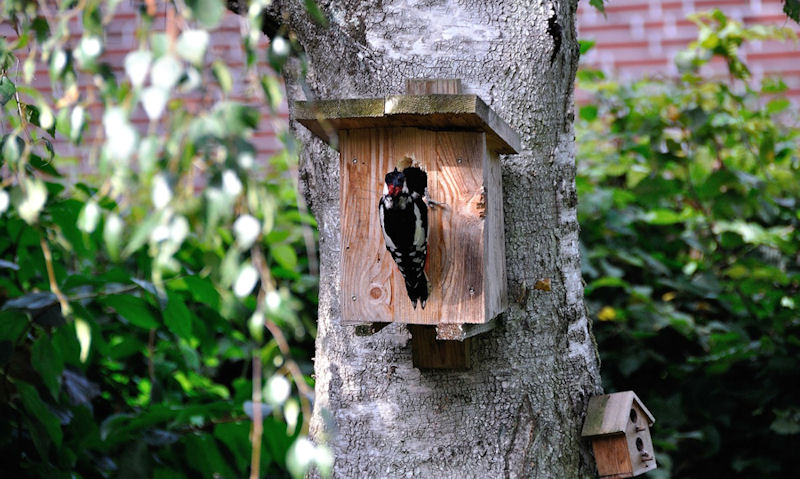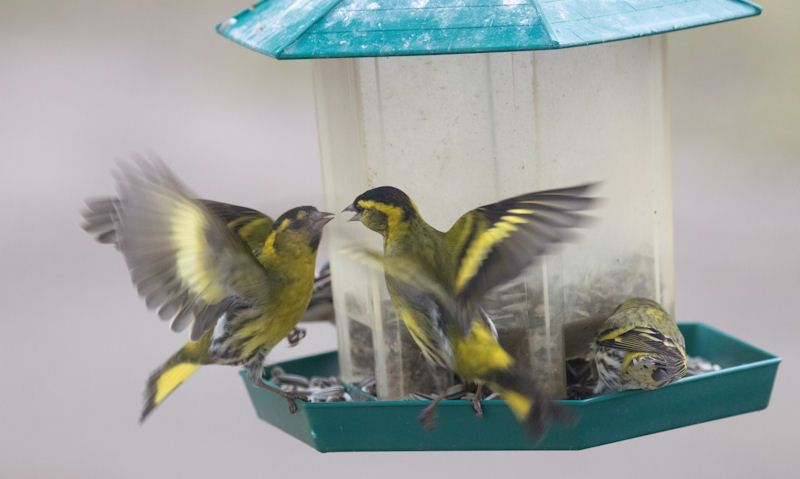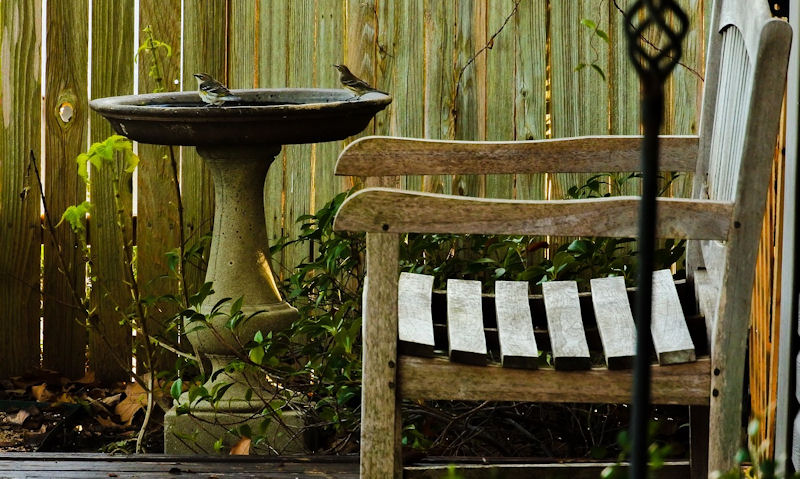What size should a bird box be
If you plan to build your own bird box and wish to get an idea of its sizing, you've come to the right place; but if you intend to buy a bird box, this guide can certainly help.
No standard size but minimum dimensions must be considered; too big or small bird boxes will see no success. Boxy bird boxes are more common and cater to more birds species at H225mm, W180mm, D180mm. Then its a matter of larger bird boxes for birds of spray, or deeper boxes for rarer, harder to attract birds.
Flexibility in building a bird box to attract common garden birds to it is a one-size fits all kind of deal - and as such these dimensions are listed on my table below.
However, when buying a bird box of any kind, targeted towards a specific species; said bird box can vary in size greatly, while still being just as effective from one bird box to the next.
When buying a bird box for a species you intend to bring to it, refer to the bird box description as the manufacturer make boxes for certain species to great effect.
To build a bird box while taking my dimensions into consideration, understand these are proximate dimensions only while referring to internal measurements.
A to big or small bird box can still attract birds you intended too, but other birds are likely to nest.
Standard bird box shape would be a square one, while height and width usually correlates to one another - with overall depth varying greatly.
Bird box dimensions table
| Bird box type: | Height: | Width: | Depth: | Hole Height: |
|---|---|---|---|---|
| Barn Owl | 670mm | 570mm | 500mm | 400mm |
| Blackbird | 180mm | 300mm | 150mm | 70mm |
| Blue Tit | 225mm | 180mm | 180mm | 125mm |
| Coal Tit | 225mm | 180mm | 180mm | 125mm |
| Great Tit | 225mm | 180mm | 180mm | 125mm |
| House Martin | 130mm | 230mm | 130mm | Top-lip |
| House Sparrow +3 | 210mm | 150mm | 150mm | 150mm |
| Jackdaw | 405mm | 200mm | 200mm | 285mm |
| Kestrel | 340mm | 300mm | 520mm | 170mm |
| Marsh Tits | 225mm | 180mm | 180mm | 125mm |
| Nuthatch | 225mm | 190mm | 190mm | 125mm |
| Pied Flycatchers | 200mm | 200mm | 180mm | 90mm |
| Pied Wagtail | 200mm | 200mm | 180mm | 90mm |
| Robin | 200mm | 200mm | 180mm | 90mm |
| Spotted Flycatcher | 200mm | 200mm | 180mm | 90mm |
| Starling | 250mm | 150mm | 150mm | 170mm |
| Stock Doves | 405mm | 200mm | 200mm | 285mm |
| Swifts | 200mm | 440mm | 200mm | 50mm |
| Swallow | 130mm | 210mm | 130mm | Open-top |
| Tawny Owl | 770mm | 220mm | 410mm | 600mm |
| Tree Sparrow | 210mm | 150mm | 150mm | 150mm |
| Woodpecker | 550mm | 200mm | 240mm | 190mm |
| Wren | 200mm | 200mm | 180mm | 90mm |
Bird box type column refers to bird species the bird box is intended for; minimum height, width and depth in millimetres; last column refers to entrance hole location on box.
No standard bird box size
Take your cue from major manufacturer's who make bird boxes for sale nationwide, all of whom never produce a single, universal bird box in one size fits all.
In fact, a standard small bird box for multiple species can vary with great success.
However, there is such a thing as going over the top size wise, so you can indeed end up with a wooden bird box built too big.
No standard bird box size but its imperative to remain in the confines of a standard bird box style, designed to attract specific garden birds to nest in it.
Entrance hole size is important, but to build or buy a bird box with a recommended, full build would be the way to go... to be safe than sorry.
Box shape NOT included
While referring to my bird box dimensions table are measurements for what would mostly be a wooden bird box, built into a square or horizontal/vertical shape.
At no point does my measurements outline for a specific bird box take into consideration the extra room that is built within the parameters of the bird box build.
But rest assured, extra space built or made available in a shop bought bird box will cause little trouble while attracting birds to it.
Box shape what I am referring to is indeed extra space above the bird box internally, that is made available from the point of the bird box roof angle, or similar.
Not a problem though as this space can indeed be useful for installing a wireless camera to view on your TV.
Minimum internal measurements
Understand, all my dimensions mentioned thus far, are referring to internal measurements only, not the extra width or depth added for external measurements.
Try to hit the bird box build that only takes internal dimensions into consideration, but it can help to consider external sizing - as a too big bird box might not fit into the intended spot in your garden.
Indeed, while only considering building a bird box with external measurements in mind, can see a bird box become far too small, so not made suitable for any common garden birds that uses bird boxes set up.
But remember, a bird box that is bought or made in a size a little too big or small, will have no baring on whether birds will or will not nest in it.
Bird species do prefer a specific bird box size so you should aim for those dimensions.
And while its still possible for the intended bird species to nest in it, you could still receive a vacancy from a bird species you didn't account for - in which case that is always going to be out of your hands.
Floor to entrance hole cut
Specific bird species, such as birds of pray, do in fact prefer a specific bird box, with one that is longer, rather than wide or boxy.
Owls, Kestrels and Woodpeckers are an example of this, as the species like a bird box that is deep - thus forcing them to nest deep down in the box, far from the entrance hole located near the top.
Floor to higher up entrance hole location is something to consider if you are indeed wishing to attract any one of these bird species.
But that must correlate with a bird box that is far larger than one intended for garden birds.
Get the recommended bird box hole size correct first thing, then make sure its a wooden bird box that has some depth.
Bird boxes designed for smaller, more common garden bird nesters is an entrance hole location more in the middle, as certain birds prefer a more shallow box.
Shallow to deep boxes
While you can reference by bird box size table above, you can take heart that certain species would happily nest in a bird box that goes far beyond what I recommend.
Example of that are the Pied Flycatchers who will indeed nest in a bird box that is far more deeper than the measurements I have listed.
Which of course you should consider as a minimum size only, as most bird boxes can be far bigger, while still seeing great success.
Similarly, you can see House Sparrows or Nuthatches nest in a box with greater depth.
However, to attract the Tit family to nest in a bird box of yours, then you should shoot for a more square bird box. And while I wouldn't class it as shallow, its more a standard size box that can cater to many more smaller birds.
All this of course doesn't refer to bird boxes for Robins or Wrens, who do prefer an open fronted bird box design... and a shallow one of that.
To summarise
For sure, certain bird species who nest in bird boxes would prefer a cavity that would replicate one found in nature, but we mustn't obsess on exact sizing.
In fact, we can be a bit more flexible when it comes to making or buying a bird box of any kind, providing we at least aim for a close size.
Its quite easy to cater to bird boxes intended for Tits or Sparrows, as the smaller bird boxes can still vary greatly in width or height.
Go one better by offering a bird box with greater depth, as common garden birds are sure to take to them also - even if its promoted for certain species.
No standard bird box size then but it certainly can help to make a bird box with the measurements I have outlined on my table above - what with them being minimum, internal measurements only.
Bird box shape can indeed make a bird box smaller or larger in certain areas, or as a whole - but you needn't worry to much about specifics.
Bird boxes can be shallow or have more depth to them, while there's really no guarantee what bird species would end up nesting in it after all.


